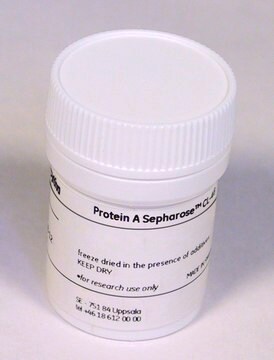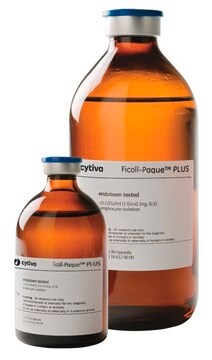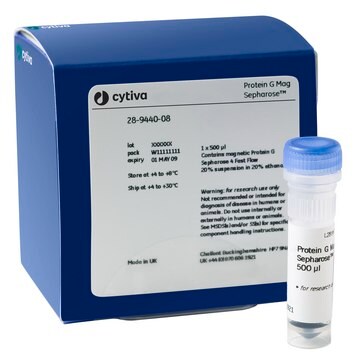P3296
Protein G Sepharose™, Fast Flow
recombinant, expressed in E. coli, aqueous ethanol suspension
Sinônimo(s):
Protein G-Agarose, Fast Flow from Streptococcus sp.
About This Item
Produtos recomendados
recombinante
expressed in E. coli
Nível de qualidade
forma
aqueous ethanol suspension
classe(s) química(is) do analito
proteins (Immunoglobulins of various mammalian species)
Extensão da rotulagem
~2 mg per mL
técnica(s)
affinity chromatography: suitable
matriz
Sepharose 4B Fast Flow
ativação da matriz
cyanogen bromide
ligação da matriz
amino
espaçador de matriz
1 atom
temperatura de armazenamento
2-8°C
Procurando produtos similares? Visita Guia de comparação de produtos
Descrição geral
P3296-5Ml′s updated product number is GE17-0618-01
Aplicação
forma física
Nota de preparo
Informações legais
produto relacionado
Palavra indicadora
Warning
Frases de perigo
Declarações de precaução
Classificações de perigo
Flam. Liq. 3
Código de classe de armazenamento
3 - Flammable liquids
Classe de risco de água (WGK)
WGK 3
Ponto de fulgor (°F)
115.0 °F - closed cup
Ponto de fulgor (°C)
46.1 °C - closed cup
Certificados de análise (COA)
Busque Certificados de análise (COA) digitando o Número do Lote do produto. Os números de lote e remessa podem ser encontrados no rótulo de um produto após a palavra “Lot” ou “Batch”.
Já possui este produto?
Encontre a documentação dos produtos que você adquiriu recentemente na biblioteca de documentos.
Os clientes também visualizaram
Protocolos
To determine the molecular weights of protein antigens, to study protein/protein interactions, to determine specific enzymatic activity, to monitor protein post-translational modifications and to determine the presence and quantity of proteins.
Nossa equipe de cientistas tem experiência em todas as áreas de pesquisa, incluindo Life Sciences, ciência de materiais, síntese química, cromatografia, química analítica e muitas outras.
Entre em contato com a assistência técnica












